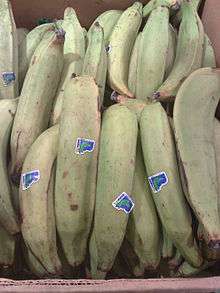True plantains
| Plantain subgroup | |
|---|---|
 Plantains for sale | |
| Genus | Musa |
| Species | Musa × paradisiaca |
| Hybrid parentage | M. acuminata × M. balbisiana |
| Cultivar group | AAB Group, Plantain subgroup |
| Origin | Southeast Asia, South Asia |
"True" plantains are a group of cultivars of the genus Musa (bananas and plantains) placed in the Plantain subgroup of the AAB genome group. The term "plantain" can refer to all the banana cultivars which are normally eaten after cooking, rather than raw (see cooking plantain), or it can refer to members of other subgroups of Musa cultivars, such as the Pacific plantains.[1] True plantains are divided into four groups based on their bunch type: French, French Horn, False Horn and Horn plantains.[2]
Each bunch type has a variety of cultivars associated to it - i.e.:[3]
- French cultivars: 'Obino l'Ewai' (Nigeria), 'Nendran' (India), 'Dominico' (Colombia)
- French Horn cultivars: 'Batard' (Cameroon), 'Mbang Okon' (Nigeria)
- False Horn cultivars: 'Agbagda' and 'Orishele' (Nigeria), 'Dominico-Harton' (Colombia)
- Horn cultivars: 'Ishitim' (Nigeria), 'Pisang Tandok' (Malaysia)
In the 1990s, the International Institute of Tropical Agriculture published two guides to help scientists and farmers identify plantains in West Africa and support their cultivation.
- The IITA Reference Guide for "Plantain cultivation under West African Conditions" (1990, page 14)[4] contains photos of different plantain types.[5]
- IITA's Research Guide 66 "Morphology and Growth of Plantain and Banana" (1997, but no longer available online, page 10) contains figures of the plantain inflorescence types.[6]
See also
- Cooking plantains
- Plantain dishes
References
- ↑ Ploetz, R.C.; Kepler, A.K.; Daniells, J. & Nelson, S.C. (2007), "Banana and Plantain: An Overview with Emphasis on Pacific Island Cultivars", in Elevitch, C.R., Species Profiles for Pacific Island Agroforestry (PDF), Hōlualoa, Hawai'i: Permanent Agriculture Resources (PAR), retrieved 2013-01-10
- ↑ http://www.promusa.org/Plantain+subgroup
- ↑ http://www.promusa.org/Plantain+subgroup
- ↑ http://biblio.iita.org/documents/U90ManSwennenPlantainNothomNodev.pdf-c21f406731488227e116b2e2001010f6.pdf
- ↑ http://biblio.iita.org/documents/U90ManSwennenPlantainNothomNodev.pdf-c21f406731488227e116b2e2001010f6.pdf
- ↑ Swennen, R. and Ortiz, R. 1997. Morphology and growth of plantain and banana. IITA Research Guide 66. Training Program, International Institute of Tropical Agriculture (IITA), Ibadan, Nigeria. (First edition, 32 pages)
